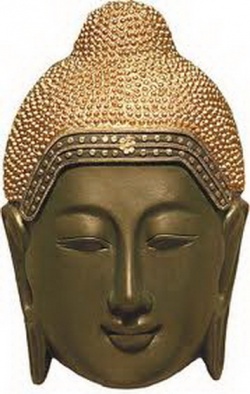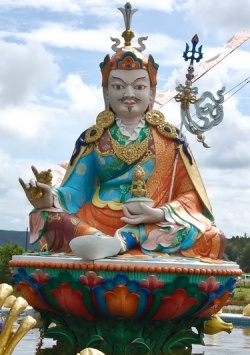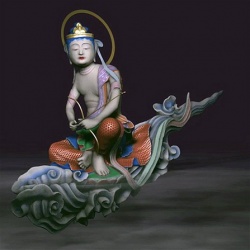Difference between revisions of "Ancient Scripts & Shambhala Texts"
(Created page with " <poem> "Chogyam Trungpa once said that when he received the Shambhala Texts, he saw them in a language that he did not understand. He wrote them down in Tib...") |
|||
| Line 1: | Line 1: | ||
| + | <nomobile>{{DisplayImages|2085|1735|3054|320}}</nomobile> | ||
| + | |||
| + | |||
| Line 5: | Line 8: | ||
"[[Chogyam Trungpa]] once said that when he received the [[Shambhala]] Texts, he saw them in a [[language]] that he did not understand. He wrote them down in [[Tibetan]], which was as close as he could get."....Robin Kornman | "[[Chogyam Trungpa]] once said that when he received the [[Shambhala]] Texts, he saw them in a [[language]] that he did not understand. He wrote them down in [[Tibetan]], which was as close as he could get."....Robin Kornman | ||
| − | The [[symbolic]] [[dakini script]] ([[mkha' | + | The [[symbolic]] [[dakini script]] ([[mkha' 'gro'i brda' yig]])....This [[terma]] [[revelation]] (below) by [[Terton]] [[Migyur Dorje]], is written in [[dakini script]] ([[yellow]] letters outlined in orange on blue background) |
“Those who see this [[script]] will not [[experience]] the [[three lower realms]] and will be {{Wiki|liberated}} from the {{Wiki|fear}} of falling into the [[lower realms]]; will be [[purified]] of the [[five poisons]] and freed from the results of one’s [[karma]]; will be freed from the {{Wiki|fear}} of remaining in [[samsara]].” — [[Terton Migyur Dorje]]. | “Those who see this [[script]] will not [[experience]] the [[three lower realms]] and will be {{Wiki|liberated}} from the {{Wiki|fear}} of falling into the [[lower realms]]; will be [[purified]] of the [[five poisons]] and freed from the results of one’s [[karma]]; will be freed from the {{Wiki|fear}} of remaining in [[samsara]].” — [[Terton Migyur Dorje]]. | ||
| Line 11: | Line 14: | ||
https://neozen888.wordpress.com/tag/dakini-script/ | https://neozen888.wordpress.com/tag/dakini-script/ | ||
| − | ...." [[terma | + | ...." [[terma of body]], {{Wiki|speech}}, [[mind]], [[quality]], and action—each {{Wiki|distinct}} from the other—and it is full of [[yellow]] scrolls, which contain [[terma]] texts in [[dakini script]].... |
| + | |||
| + | Inside was a small [[yellow]] scroll, about two fingerwidths wide, which contained [[dakini script]] by [[Yeshe Tsogyal]], which is not understandable to ordinary people......http://nalandatranslation.org/projects/articles/trungpa-rinpoches-early-days-as-a-terton/ | ||
"In the [[Nyingma tradition]], the oldest [[Buddhist]] school, [[exist]] some other scripts named "[[terma]] scripts" or "[[dakini scripts]]". .....http://www.dakiniscripts.at | "In the [[Nyingma tradition]], the oldest [[Buddhist]] school, [[exist]] some other scripts named "[[terma]] scripts" or "[[dakini scripts]]". .....http://www.dakiniscripts.at | ||
| − | |||
| − | "[[Zhang-Zhung]] ([[Tibetan]]: {{BigTibetan|ཞང་ཞུང}}, [[Wylie]]: [[zhang zhung]]) is an [[extinct]] Tibeto-Burman | + | "[[Lantsha]]- and [[Vartu-script]].....there are only few [[people]] in the [[world]] who can read or write [[Lantsha]]- and [[Vartu-script]] and even fewer who have [[experience]] and expert [[knowledge]] of the [[Bon]] [[Smar-script]] and the different kinds of [[Zhang-zhung]] scripts......the [[ancient]] and [[divine]] scripts used by [[Buddhist monks]] in [[India]] and [[Tibet]] in the 11th century..... |
| + | |||
| + | Common [[belief]] is that most [[Buddhist Sanskrit]] [[manuscripts]] of the 11th century are written in [[Ranjana]]. | ||
| + | |||
| + | But that is not the case. The importance of the {{Wiki|Nepalese}} [[Ranjana]] is well known, but for [[Buddhist tradition]] the diversification and [[development]] from [[Ranjana]] into the [[Lantsha]] and Vartu [[script]] is more important. Although [[Ranjana]] and [[Lantsha]] are often described as similar there is a large amount of variation at the detailed [[script]] level. ..... | ||
| + | |||
| + | Both scripts, [[Lantsha]] and [[Vartu]], became the [[fundamental vehicle]] of [[Buddhist]] textual [[tradition]]. [[Lantsha]] [[script]] not only acts as a binding force for the [[Buddhist community]], but what is more important these [[signs]] are a {{Wiki|distinct}} mark of identification in [[mantras]] and [[Buddhist texts]]. | ||
| + | |||
| + | For example the [[Buddhist]] [[Mahayana]] text in [[Lantsha]] was transferred from [[India]] to [[Tibetan monasteries]]. ..... | ||
| + | |||
| + | In some [[monasteries]] and other [[traditional]] places [[translators]] developed their [[own]] scripts out of the [[Brahmi scripts]] similar to [[Lantsha]] and [[Vartu]] and used these scripts to transcribe [[Tibetan]] written [[thoughts]] and commentaries [[to expand]] the {{Wiki|literature}} at those {{Wiki|holy}} places. | ||
| + | |||
| + | {{Wiki|Calligraphy}} of all the developed scripts became a [[meditating]] point for the [[Buddhist monks]] and [[spiritual]] [[education]] in [[Tibetan monasteries]]. | ||
| + | |||
| + | Up to now these scripts have considerable influence on the {{Wiki|aesthetic}} and [[intellectual]] [[achievement]] of [[Buddhist]] [[society]] and culture..."....http://www.lantsha-vartu.org | ||
| + | |||
| + | "[[Zhang-Zhung]] ([[Tibetan]]: {{BigTibetan|[[ཞང་ཞུང]]}}, [[Wylie]]: [[zhang zhung]]) is an [[extinct]] [[Tibeto-Burman language]] that was spoken in what is now [[western Tibet]]. | ||
| + | |||
| + | The term '{{Wiki|Zhang-zhung language}}' has been used to refer to two different entities. One of these occurs occasionally in the [[scriptures]] of the [[Bön]] [[religion]]. | ||
| + | |||
| + | The other, 'Old [[Zhang-zhung]]', appears in a small number of documents preserved in [[Dunhuang]]. | ||
| + | |||
| + | The [[language]] of these texts was identified as '[[Zhang-zhung]]' by F. W. Thomas and this identification has been accepted by [[Takeuchi Tsuguhito]] ([[武内紹人]]). However, [[Dan Martin]] questions the [[wisdom]] of identifying these as variants of the same language."....[[Dan Martin]] (2004), "[[Zhang-zhung]] {{Wiki|Dictionary}}". | ||
| + | |||
| + | A Cavern of [[Treasures]] ([[Tibetan]]: {{BigTibetan|[[མཛོད་ཕུག]]}}, [[Wylie]]: [[mdzod phug]]) is a [[terma]] uncovered by [[Shenchen Luga]] ([[Tibetan]]: {{BigTibetan|[[གཤེན་ཆེན་ཀླུ་དགའ]]}}, [[Wylie]]: [[gshen chen klu dga']]) in the early eleventh century. | ||
| − | + | Martin identifies the importance of this [[scripture]] for studies of the [[Zhang-zhung language]]:.....For students of [[Tibetan culture]] in general, the [[mDzod phug]] is one of the most intriguing of all [[Bön scriptures]], since it is the only lengthy bilingual work in [[Zhang-zhung]] and [[Tibetan]] (some of the shorter but still significant sources for [[Zhang-zhung]] are signaled in Orofino 1990)."....Dan Martin (2004), "[[Zhang-zhung]] {{Wiki|Dictionary}}"...... | |
Early [[terma]] as found manuscripts.....http://blogs.orient.ox.ac.uk/kila/2010/09/17/early-terma-as-found-manuscripts/ | Early [[terma]] as found manuscripts.....http://blogs.orient.ox.ac.uk/kila/2010/09/17/early-terma-as-found-manuscripts/ | ||
Latest revision as of 06:15, 6 November 2015
"Chogyam Trungpa once said that when he received the Shambhala Texts, he saw them in a language that he did not understand. He wrote them down in Tibetan, which was as close as he could get."....Robin Kornman
The symbolic dakini script (mkha' 'gro'i brda' yig)....This terma revelation (below) by Terton Migyur Dorje, is written in dakini script (yellow letters outlined in orange on blue background)
“Those who see this script will not experience the three lower realms and will be liberated from the fear of falling into the lower realms; will be purified of the five poisons and freed from the results of one’s karma; will be freed from the fear of remaining in samsara.” — Terton Migyur Dorje.
https://neozen888.wordpress.com/tag/dakini-script/
...." terma of body, speech, mind, quality, and action—each distinct from the other—and it is full of yellow scrolls, which contain terma texts in dakini script....
Inside was a small yellow scroll, about two fingerwidths wide, which contained dakini script by Yeshe Tsogyal, which is not understandable to ordinary people......http://nalandatranslation.org/projects/articles/trungpa-rinpoches-early-days-as-a-terton/
"In the Nyingma tradition, the oldest Buddhist school, exist some other scripts named "terma scripts" or "dakini scripts". .....http://www.dakiniscripts.at
"Lantsha- and Vartu-script.....there are only few people in the world who can read or write Lantsha- and Vartu-script and even fewer who have experience and expert knowledge of the Bon Smar-script and the different kinds of Zhang-zhung scripts......the ancient and divine scripts used by Buddhist monks in India and Tibet in the 11th century.....
Common belief is that most Buddhist Sanskrit manuscripts of the 11th century are written in Ranjana.
But that is not the case. The importance of the Nepalese Ranjana is well known, but for Buddhist tradition the diversification and development from Ranjana into the Lantsha and Vartu script is more important. Although Ranjana and Lantsha are often described as similar there is a large amount of variation at the detailed script level. .....
Both scripts, Lantsha and Vartu, became the fundamental vehicle of Buddhist textual tradition. Lantsha script not only acts as a binding force for the Buddhist community, but what is more important these signs are a distinct mark of identification in mantras and Buddhist texts.
For example the Buddhist Mahayana text in Lantsha was transferred from India to Tibetan monasteries. .....
In some monasteries and other traditional places translators developed their own scripts out of the Brahmi scripts similar to Lantsha and Vartu and used these scripts to transcribe Tibetan written thoughts and commentaries to expand the literature at those holy places.
Calligraphy of all the developed scripts became a meditating point for the Buddhist monks and spiritual education in Tibetan monasteries.
Up to now these scripts have considerable influence on the aesthetic and intellectual achievement of Buddhist society and culture..."....http://www.lantsha-vartu.org
"Zhang-Zhung (Tibetan: ཞང་ཞུང, Wylie: zhang zhung) is an extinct Tibeto-Burman language that was spoken in what is now western Tibet.
The term 'Zhang-zhung language' has been used to refer to two different entities. One of these occurs occasionally in the scriptures of the Bön religion.
The other, 'Old Zhang-zhung', appears in a small number of documents preserved in Dunhuang.
The language of these texts was identified as 'Zhang-zhung' by F. W. Thomas and this identification has been accepted by Takeuchi Tsuguhito (武内紹人). However, Dan Martin questions the wisdom of identifying these as variants of the same language."....Dan Martin (2004), "Zhang-zhung Dictionary".
A Cavern of Treasures (Tibetan: མཛོད་ཕུག, Wylie: mdzod phug) is a terma uncovered by Shenchen Luga (Tibetan: གཤེན་ཆེན་ཀླུ་དགའ, Wylie: gshen chen klu dga') in the early eleventh century.
Martin identifies the importance of this scripture for studies of the Zhang-zhung language:.....For students of Tibetan culture in general, the mDzod phug is one of the most intriguing of all Bön scriptures, since it is the only lengthy bilingual work in Zhang-zhung and Tibetan (some of the shorter but still significant sources for Zhang-zhung are signaled in Orofino 1990)."....Dan Martin (2004), "Zhang-zhung Dictionary"......
Early terma as found manuscripts.....http://blogs.orient.ox.ac.uk/kila/2010/09/17/early-terma-as-found-manuscripts/
Source
http://balkhandshambhala.blogspot.com.au/2012/12/shamis-en-balkh-ancient-scripts.html



